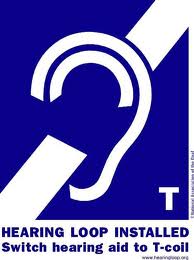by Ann L. Rhoten, Au.D., CCC/A
 Although hearing aid technology has significantly improved since digitalization in the 1990s, there continue to be situations which challenge and frustrate hearing impaired listeners. Places of worship, airports, theaters, ticket booths and movie theaters tend to be extremely difficult listening environments. Often times creating such an unsatisfying experience that the hearing impaired person avoids the situation entirely. If hearing aids are so advanced, why do they continue to have problems with reproducing a clear sound in these situations? The answer is the microphone. In large reverberant rooms, the sound is degraded before it reaches the hearing aid microphone. The hearing aid can only reproduce the input provided. If the microphone detects a degraded signal, it will amplify a degraded signal sometimes making speech totally unintelligible.
Although hearing aid technology has significantly improved since digitalization in the 1990s, there continue to be situations which challenge and frustrate hearing impaired listeners. Places of worship, airports, theaters, ticket booths and movie theaters tend to be extremely difficult listening environments. Often times creating such an unsatisfying experience that the hearing impaired person avoids the situation entirely. If hearing aids are so advanced, why do they continue to have problems with reproducing a clear sound in these situations? The answer is the microphone. In large reverberant rooms, the sound is degraded before it reaches the hearing aid microphone. The hearing aid can only reproduce the input provided. If the microphone detects a degraded signal, it will amplify a degraded signal sometimes making speech totally unintelligible.
With the passage of the Americans with Disability Act many churches, theaters and other large locations have installed wireless transmitters which use infrared and FM technology to send the signal to the hearing impaired patrons. Both are effective means of transmitting speech clearly but in order for the hearing impaired person to access the technology special headsets/receivers must be checked out and worn. Experience has shown people are reluctant to use this technology, typically due to the stigma and hassle of checking out headsets which are conspicuous, unable to be used with existing amplification and incapable of being used in other settings.
Fortunately there has been a resurgence of a seasoned but effective technology called hearing loops. Hearing loops are like Wi-Fi for your hearing aid. They turn the hearing instruments into wireless speakers for a PA system or television set. A hearing loop works through wirelessly transmitting the signal from a PA system or television through a magnetic field to a small copper coil, called a telecoil, in a hearing aid. The telecoil picks up the signal from the magnetic field and converts it back into an acoustic signal in the hearing aid. Because the signal is never airborne, it provides a clear, intelligible sound with no interference from background noise and no degradation of the signal due to reverberation.
Estimates suggest sixty to seventy percent of hearing aids come standard with a telecoil. The telecoil need only be activated and programmed by an audiologist. Anytime the hearing aid user is in a facility which is looped, the telecoil can be accessed by pushing a button at the back of the hearing aid.
There are many advantages of a hearing loop over infrared and FM systems. First, most hearing aids are equipped with a microphone plus telecoil setting enabling one to hear the people nearby while simultaneously receiving direct input from the PA system. With infrared and FM headsets, only the input from the PA system is received sometimes making it difficult to communicate with those around you. Additional benefits of hearing loops include no need for extra equipment to be checked out, the telecoil can be utilized in any looped venue, simple to access, hygienic and provides clear, intelligible sound. In the event there is no telecoil in your hearing aid or one does not wear a hearing aid, just like FM and infrared, listening devices are available for check out.
In 2010, the Hearing Loss Association of America and the American Academy of Audiology announced a joint collaborative public education campaign “Get in the Hearing Loop”. The campaign aims to enlighten and excite hearing aids users, as well as audiologist and other professionals who dispense hearing aids regarding telecoils, hearing loops and their unique benefits. As a result of the campaign, Michigan, Wisconsin, New York, California and North Carolina have installed a significant number of loops. The list of places that are looped is long and varied but include small, portable loops for example check-out counters, drive-thru windows, taxi-cabs, tour buses and large permanent loops in theaters and churches. Lexington is lucky to have the Kentucky Theater and Northeast Christian Church looped. In addition, a TV in a room in my office has been looped for demonstration purposes. For more information go to www.loopamerica.com or to www.hearingloop.org or contact the author at arhoten@kytinnitustreatment.com.


